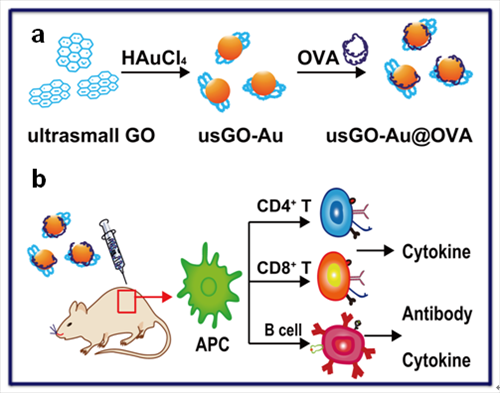Vaccines are widely used to prevent or even eliminate infectious diseases, in which adjuvants play an important role. Despite that great progress has been made in immunology in recent years, the adjuvant used in human vaccine, however, is largely dependent on the aluminum-based materials. The major limitation of the aluminum adjuvants is their poor capability of eliciting cell-mediated immune response that is required to control most intracellular pathogens and cancer. Recently, a research group led by Professor Zhijun Zhang at Suzhou Institute of Nano-tech and Nano-bionics, Chinese Academy of Sciences, in collaboration with Professor Huichen Guo, Lanzhou Veterinary Research Institute, Chinese Academy of Agricultural Sciences, has developed a new immune adjuvant based on ultra-small graphene oxide (usGO) supported gold nanoparticles (AuNPs) for improving humoral and cellular immune responses. The researchers prepared the usGO-Au composites by in-situ growing of the Au NPs on the surfaces of the usGO sheets through direct reduction of chloroauric acid by usGO. Thus-prepared usGO-Au composites significantly improved the binding capacity of the AuNPs to ovalbumin (OVA). Furthermore, the in vitro and in vivo studies demonstrated that the usGO-Au@OVA composites promoted much stronger cellular immunity response than the alum adjuvant and comparable humoral immunity response. This study provides new insights into rational design of nanomaterials as a versatile platform for immunity promoting. The paper entitled “Ultra-small graphene oxide-supported gold nanoparticles as adjuvant improves humoral and cellular immunity in mouse” was recently published in Advanced Functional Materials (Advanced Functional Materials, 2014, 24, 6963–6971). This work was supported by National Natural Science Foundation, the Ministry of Science and Technology of China, and the State Key Laboratory of Veterinary Etiological Biology, Lanzhou Veterinary Research Institute, Chinese Academy of Agricultural Sciences. 
Figure: Schematic illustration of (a) preparation of usGO-Au@OVA vaccine and (b) procedure for assessment of humoral and cellular immunity in vivo. |

